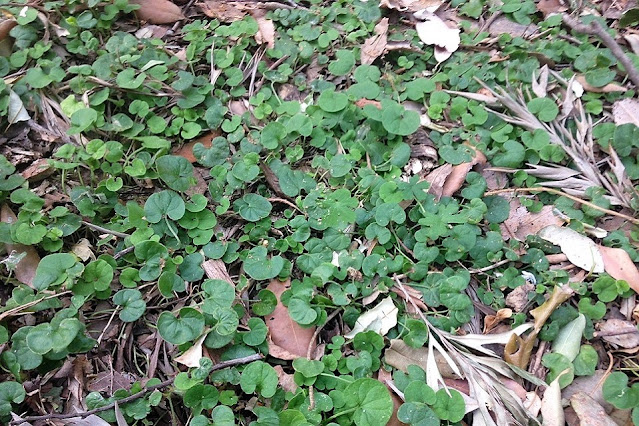Are you struggling to tell you Kidney Weed from your Gotu Kola? Have you got some unfamiliar round-leaves plants growing in your lawn, and want help working out what they are? If so this post is for you! Elena Martinez from the Growing Illawarra Natives team recently provided a practical and well-illustrated guide to Kidney Weed and its look-alikes on the Growing Illawarra Facebook page. I've adapted Elena's post for the Growing Illawarra Natives blog.
Kidney Weed, Dichondra repens, also known as Dichondra, is a locally common low-growing ground-cover that forms dense mats in suitable conditions. NSW PlantNET gives its Dharawal language name as yilibili. Dichondra's natural distribution is wide and it occurs in every state and territory apart from the Northern Territory. It is also widely cultivated and used in gardens and landscaping, being one of the most regularly seen ground cover species across coastal eastern Australia and south-west Western Australia. It's a low-maintenance option for a wide range of garden situations, and easily sourced.
 |
| This is Kidney Weed (Dichondra repens) growing in a natural area in wet sclerophyll forest. Image by Emma Rooksby. |
One of the most common look-alikes is another native species, Gotu Kola or Centella asiatica. It has a distinctive V- shaped gap where the stem meets the leaf, as the image below shows. It also indicates how tall Gotu Kola can grow. Both species can root from nodes on their stems, meaning a patch of either species usually has many separate sets of roots. Those of Gotu Kola are more robust and fleshier than those of Dichondra.
When seen side by side, it's easier to pick the differences between Gotu Kola (Centella asiatica), shown on the left, and Kidney Weed (Dichondra repens), on the right.
An introduced species that can be confused with both of these local species, especially when it's not in flower, is the Red-flowered Mallow Modiola caroliniana, which comes from Southern America and is now widespread in gardens across NSW and beyond. It has orange flowers, which when present make it easy to distinguish from Dichondra and Centella, which have small, inconspicuous yellow-green or yellow-white flowers.
Like Dichondra and Centella, Red-flowered Mallow's stems root at the nodes. This makes removal difficult as every portion with roots needs to be removed.
 |
| Stems of Red-flowered Mallow, showing its low-growing character. You can more or less glimpse some nodes with roots running across more or less the centre of the image. Image by Elena Martinez. |
A couple of other fairly common local native look-alikes include the Native Violet Viola hederacea, and two species of Pennywort, Hydrocotyle peduncularis and H. tripartita.









No comments
Post a Comment